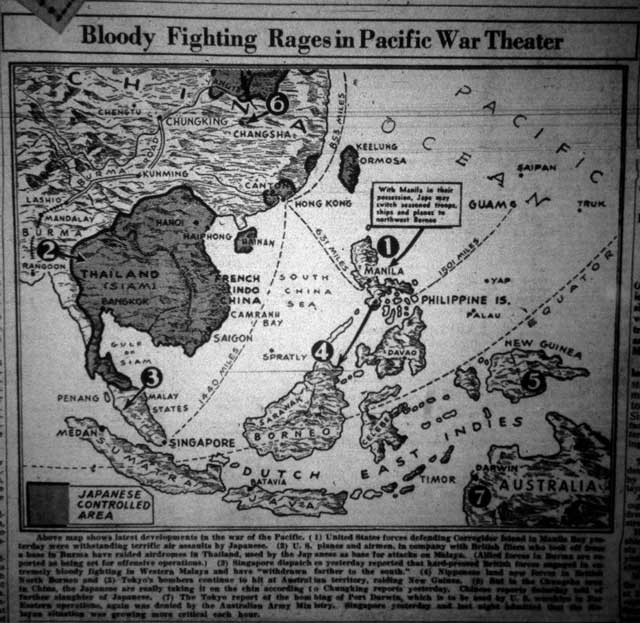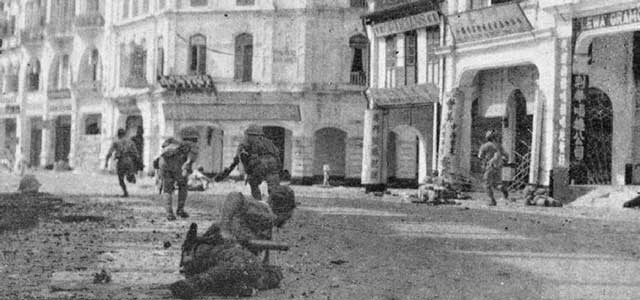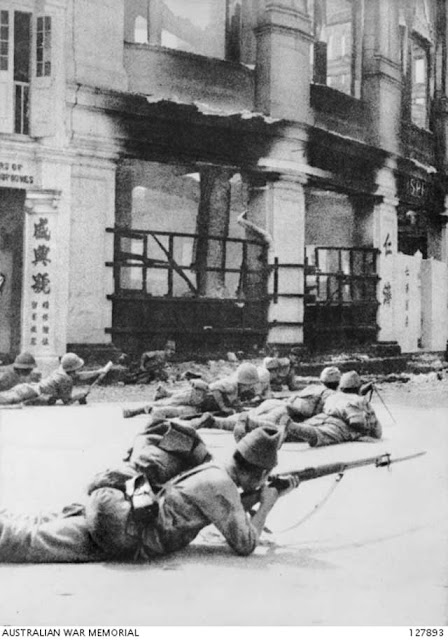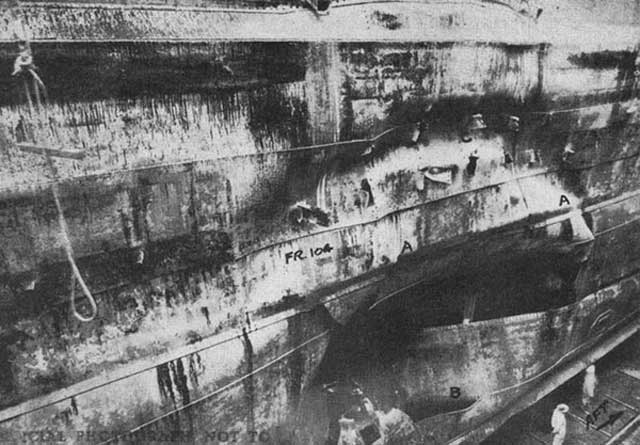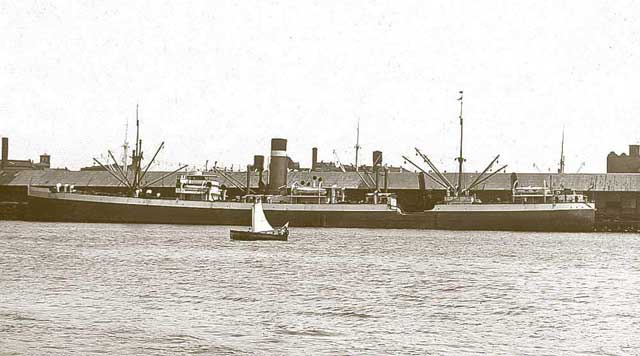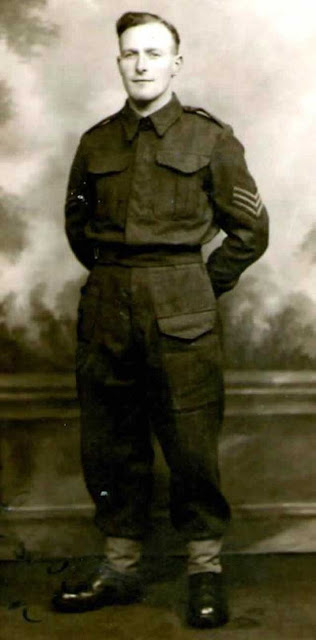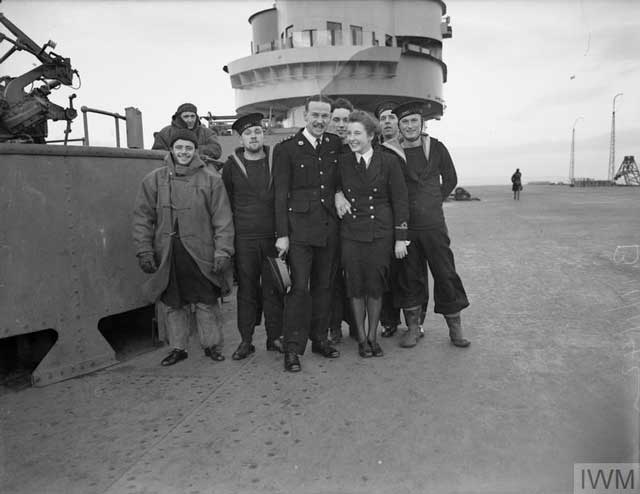Monday 2 February 1942
 |
| "A British destroyer flotilla taking part in Mediterranean operations." This photo was taken on board HMS Jervis in the eastern Mediterranean, 2 February 1942 (© IWM (A 8576)). |
Eastern Front: The winter has bent but not quite broken the Wehrmacht, and by 2 February 1942 it is fighting back to protect its most vital arteries. The
Rollbahn, a major (for Russia) road from Yukhnov to Gzhatsk, is the lifeline to Fourth Army in the Moscow sector, and the Soviets have held it for a week. The Germans now are fighting furiously from either end of the road to open it up, with General Heinrici sending his Fourth Army troops south and General Ruoff advancing with his Fourth Panzer Army vehicles north toward him. They make good progress today, though they do not quite close the gap and reopen the road yet. There are supplies waiting behind Ruoff's forces to be sluiced through the moment the road is cleared. This is one of the most important operations of the winter because until the road is cleared, the Fourth Army must rely on air support. The Luftwaffe already is hard-pressed supplying surrounded garrisons at Kholm, Demyansk, and elsewhere, so clearing the road is a top priority.
 |
| "Major the Earl of Bradford (right) directs his company of the Home Guard during exercises with regular troops, 2 February 1942." © IWM (H 17543). |
As the Germans regain their footing on the Eastern Front, their ambitions begin to expand again. General Dietl, commanding the Army of Lapland, is trying to convince the Finns to participate in an attack to cut the Soviet railway line to Murmansk at Belomorsk. Marshal Mannerheim, commanding all Finnish forces, is noncommital but indicates that he would be ready to participate in such an operation once the Germans capture Leningrad. Of course, the Germans have no hope of capturing Leningrad anytime soon due to their difficulties on the main front and pretty much everyone knows that. German General Waldemar Erfurth, who leads the German liaison team at Mannerheim's headquarters, reports back to OKW that Mannerheim has a pessimistic view of the war and is unwilling to stage any attacks that he has any chance of losing. Mannerheim prepares a letter to General Keitel today which basically expresses these views. The Germans have no alternatives in the northern sector of the front and are at Mannerheim's mercy.
 |
| Life Magazine for 2 February 1942 features a Republic P-48 Thunderbolt on the cover. The XP-47B prototype, designed by Alexander Kartveli, first flew on 6 May 1941. There are only the XP-47B and an engineering prototype in existence during February 1942, so this truly is a cutting edge photo and undoubtedly had to pass through military censors. |
Battle of the Pacific: In the Philippines, the fighting along the Main Line of Resistance (MLR) on the Bataan Peninsula has died down while the Japanese reinforce their presence for a decisive attack. However, the Allies continue strenuously battling Japanese pockets and bridgeheads behind the MLR, some very close to the MLR and others many miles to the south. On the eastern half of the MLR, US II Corps eliminates a small Japanese bridgehead across the Pilar River when the last Japanese leave after dark. On the western half of the MLR, the Americans send tanks of the US 192d Tank Battalion supported by a platoon of the 1st Battalion, 45th Infantry, Philippine Scouts, against the "Big" Japanese pocket. However, the Japanese are dug in and hold their ground in the rough terrain. Much further south, the Americans try the same formula (tanks of the 192d and Filipino Scouts) against the Quinauan Point beachhead. However, the Japanese there have been cheered by ultimately unsuccessful Japanese attempts to resupply and reinforce them, so they also resist the Allies. Those reinforcements, which the Allies diverted to the Anyasan-Silaiim sector, also hold out against fierce attacks by the Scout battalions (2d Battalion of the 45th Infantry; 3d and 1st Battalions of the 57th Infantry. The day's events are discouraging for the Allies, but the MLR provides a growing sense of security and the hope that they can hold the Bataan Peninsula indefinitely.
In the Netherlands East Indies, Japanese troops continue occupying Ambon Island, home to an important naval base. The Japanese take Laha Airdrome from Australian troops during the morning. Later in the day, the surviving Australian troops send a surrender parley under a white flag carried by Major Newberry, the commanding officer at Laha. The Japanese promptly imprison them in the local school for the night. Offshore, Dutch mines sink Japanese minesweeper W-9 and damage minesweepers W-11 and W-12.
 |
| "Kepper Harbour, Singapore. 2 February 1942. Men of HMAS Hobart returning electric sewing machines in wooden crates that they had found in a godown (storage shed where incoming merchant goods were stored after unloading), just before the fall of Singapore. Approximately fifty sailors were placed under guard on the quarterdeck by the gunnery officer before Captain H. Howden returned to the ship from the dockyard and ordered the sailors to return the machines to the godown. However, some machines were brought back to the ship with a lot of other selected material. The Captain returned to the ship with a car and the dockyard crest, both of which were shipped back to Australia. (Donor M. Williams)" Australian War Memorial P02497.026. |
This is the last relatively quiet day in Singapore, as the Japanese have not yet brought up artillery. The British have blown the causeway to the mainland and organized their defenses into three sectors: Northern, Southern, and Western. The largest RAF airfield is at RAF Tengah in the Western Area, but the planes have almost all been withdrawn to the Netherlands East Indies. The most vulnerable area for an invasion is recognized as the northwest part of Singapore, where there are mangrove swamps, jungles, creeks, and rivers. The British are still able to receive reinforcements and leave by sea, and there really isn't much sense of urgency in the city.
 |
| Tamagawa Maru, sunk by USS Seadragon on 2 February 1942. |
USS Seadragon (SS-194), on its first patrol out of Soerabaja, Netherland East Indies, sinks 6441-ton Japanese freighter Tamagawa Maru off Cape Bolinao, Luzon. Seadragon attacks a five-ship convoy off San Fernando and sinks the fourth ship in the line. This is of great aid to the Allies in Bataan, as the ship carried reinforcements and equipment for the coming Japanese offensive.
Following the successful Marshalls-Gilbert Raids of 1 February, Admiral Halsey retires with his task force from the area in bright moonlight. The US Navy ships are shadowed by Japanese planes and a submarine but escape unscathed at 25 knots. The ships encounter a sudden storm during the morning, which they use to screen themselves from the Japanese. Halsey proudly tells that the task force that it has "made history in the Marshalls."
 |
| FV Cape Spartel, one of the ships sunk by the Luftwaffe on 2 February 1942. |
European Air Operations: There is a week-long lull in strategic air operations along the western front due to winter conditions. About twenty German aircraft do mount a raid on the Humber and bomb and sink 346-ton HMT Cape Spartel and also 324-ton HMT Cloughton Wyke at Yarmouth.
 |
| Admiral Doenitz graces the cover of Time Magazine, 2 February 1942 (cover credit: Vuk Vuchinich). |
Battle of the Atlantic: British escort destroyer HMS Westcott (D47) sinks U-581 (Kptlt. Werner Pfeifer) off the south exit from Horta Harbor, Azores, Portugal. U-581 was caught on the surface after an unsuccessful torpedo attack on Westcott and accompanying destroyer Croome. Due to a mechanical issue, U-581 could not submerge, and Westcott succeeds in a second attempt to ram it. Almost the entire U-581 crew, 41 men, survive after being picked up by the destroyers, while four men perish. One German sailor, Oblt. Walter Sitek, survives by swimming six km (well over three miles) to shore (he is repatriated to Germany, becomes a U-boat commander, and survives the war). U-581 ends its career having sunk one ship, HMS Rosemonde on 19 January 1942, of 364 tons.
U-103 (Kptlt. Werner Winter), on its sixth patrol out of Lorient, is operating off the east coast of the United States as part of Operation Paukenschlag (Drumbeat). Winter gets his first sinking of the patrol when he torpedoes and then shells 6182-ton US tanker W. L. Steed about 85 nautical miles (160 km) east of the mouth of the Delaware River. The weather is horrendous, with snow and icy temperatures, so many of the 38 men who take to the boats perish from exposure. Ultimately, there are 34 dead and four survivors.
 |
| Ernst Kals, commander of U-130. |
Operation Paukenschlag was never intended by the Germans to be a lengthy offensive. The original plan was to send one wave of five U-boats (U-66, U-109, U-123, U-125, and U-130) in early 1942 and then return focus to the convoy routes. However, the unexpected success of the U-boats along the east coast of the United States has led to a decision to continue the offensive with new waves of boats. The first wave of U-boats already is returning to Europe, with U-130 (Ernst Kals) exiting the area south of Cape Sable on 2 February. It heads back to Lorient, though it first has a rendezvous with U-109 (Heinrich Bleichdrodt), which also is leaving the area, in the mid-Atlantic in order to transfer some fuel.
 |
| W. L. Steed, sunk by U-103 on 2 February 1942. |
The Royal Navy has been keeping a close eye on German heavy cruisers Gneisenau and Scharnhorst, which have been bottled up in Brest, France, for the better part of a year. They are within easy bombing range of the RAF, but winter conditions have not been suitable for a decisive air attack on them. Since that will soon change with the passing of seasons, the Germans have been busy readying the ships for action. The British Naval Staff, perhaps operating off of decoded German radio transmissions, begins planning to stop an expected cruise of the large German ships up the English Channel and back to Germany. This is considered extremely dangerous by both sides, as the ships would have to make much of the journey during daylight when the RAF could easily attack. However, Adolf Hitler believes that the risks are worthwhile because of Allied control of the air and sea in the Atlantic and the ships can be put to some use in northern Norway. Thus, the Germans have begun planning Operation Cerberus, also known as the Channel Dash.
Battle of the Mediterranean: German Lieutenant General Erwin Rommel's troops continue their rapid march from Benghazi. The Afrika Korps is advancing in two columns. The coastal column captures Berta but is stopped a dozen miles west of Derna. The inland column advances further, stopping south of Derna. In Cairo, General Claude Auchinleck, Commander in Chief Middle East Command, can see what is coming and tells his Eighth Army commanders that he expects them to hold Tobruk.
 |
| The Air Training Corps (ATC) Gazette Vol. II No. 2, February 1942. |
US Military: VII Interceptor Command is activated at Ft Shafter in Hawaii.
Major General Joseph W. Stilwell becomes Chief of Staff to Supreme Commander, China Theater (Chiang Kai-shek). His portfolio is to:
increase the effectiveness of United States assistance to the Chinese Government for the prosecution of the war and to assist in improving the combat efficiency of the Chinese Army.
Stilwell cannot do much about the Chinese Army, but he helps to sort out the chaos of Lend-Lease shipments to China.
The Headquarters of the USAAF 49th Pursuit Squadron (Interceptor) arrives in Melbourne, Victoria. They are equipped with P-40s, the most plentiful USAAF fighter at this time. These are raw pilots just out of flight school and their first assignment is to help put their own planes together from the crates in which they were shipped.
Egypt: The entire British position in the Mediterranean hinges on keeping a tight grip on Egypt. However, that grip is shaken today when King Farouk, who is known to harbor Axis sympathies, forces his entire cabinet to resign.
Holocaust: The commandant at the Auschwitz camp institutes a new "reeducation" policy for some prisoners (Erziehungshäftlinge). This involves giving such prisoners a new series of numbers (beginning EH 1) that are distinct from the general series of numbers. A total of 1137 such numbers are issued. These reeducation prisoners live under the same conditions as other prisoners in the camp but are released after a limited period not to exceed eight weeks (though this time limit is not honored in actuality and many spend much longer in the camp). Ultimately, about 11,000 prisoners in this category pass through Auschwitz.
American Homefront: The Federal Bureau of Investigation is rounding up suspected Japanese spies, as evidenced by a headline in the 2 February 1942 Seattle Daily Times which reads, "FBI Ousts Nipponese in Island Raid."
 |
| Bow view of the USS Silversides (SS-236) off Mare Island, California, 2 February 1942 (U.S. Navy). |
February 1942February 1, 1942: The US Navy Strikes BackFebruary 2, 1942: Germans Recovering in RussiaFebruary 3, 1942: Japanese Shell and Bomb SingaporeFebruary 4, 1942: Battle of Makassar StraitFebruary 5, 1942: Empress of Asia SunkFebruary 6, 1942: The Christmas Island BodyFebruary 7, 1942: The Double-V CampaignFebruary 8, 1942: Japan Invades SingaporeFebruary 9, 1942: French Liner Normandie CapsizesFebruary 10, 1942: US Car Production EndsFebruary 11, 1942: Tomforce Fails on SingaporeFebruary 12, 1942: The Channel DashFebruary 13, 1942: Japanese Paratroopers In ActionFebruary 14, 1942: RAF Orders Terror RaidsFebruary 15, 1942: Japan Takes Singapore
February 17, 1942: Indian Troops Defect to JapaneseFebruary 18, 1942: Battle of Badung StraitFebruary 19, 1942: FDR Authorizes Internment CampsFebruary 20, 1942: O'Hare the HeroFebruary 21, 1942: Crisis in BurmaFebruary 22, 1942: Bomber Harris Takes OverFebruary 23, 1942: Bombardment of Ellwood, CaliforniaFebruary 24, 1942: US Raid on Wake IslandFebruary 25, 1942: Battle of Los AngelesFebruary 26, 1942: Gneisenau EliminatedFebruary 27, 1942: Battle of Java SeaFebruary 28, 1942: Battle of Sunda Strait2020













